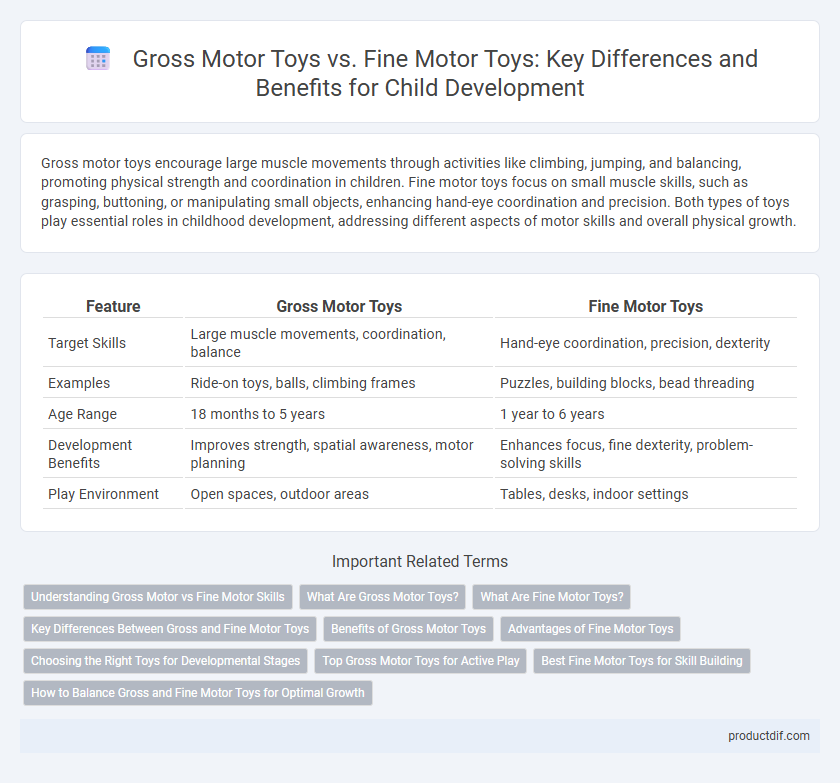Gross motor toys encourage large muscle movements through activities like climbing, jumping, and balancing, promoting physical strength and coordination in children. Fine motor toys focus on small muscle skills, such as grasping, buttoning, or manipulating small objects, enhancing hand-eye coordination and precision. Both types of toys play essential roles in childhood development, addressing different aspects of motor skills and overall physical growth.
Table of Comparison
| Feature | Gross Motor Toys | Fine Motor Toys |
|---|---|---|
| Target Skills | Large muscle movements, coordination, balance | Hand-eye coordination, precision, dexterity |
| Examples | Ride-on toys, balls, climbing frames | Puzzles, building blocks, bead threading |
| Age Range | 18 months to 5 years | 1 year to 6 years |
| Development Benefits | Improves strength, spatial awareness, motor planning | Enhances focus, fine dexterity, problem-solving skills |
| Play Environment | Open spaces, outdoor areas | Tables, desks, indoor settings |
Understanding Gross Motor vs Fine Motor Skills
Gross motor toys develop large muscle groups used for activities like running, jumping, and climbing, crucial for overall physical coordination and balance. Fine motor toys enhance precise hand-eye coordination, dexterity, and control needed for tasks such as writing, buttoning, and manipulating small objects. Understanding the distinction between gross motor and fine motor skills helps caregivers select toys that support targeted developmental milestones in children.
What Are Gross Motor Toys?
Gross motor toys are designed to develop large muscle movements such as crawling, walking, jumping, and balancing. Examples include ride-on vehicles, balls, climbing structures, and jump ropes that promote physical strength, coordination, and overall body control. These toys support children's gross motor skill development vital for activities like running, throwing, and maintaining balance.
What Are Fine Motor Toys?
Fine motor toys are designed to enhance small muscle movements in the hands and fingers, promoting dexterity and hand-eye coordination in children. These toys often include puzzles, bead stringing kits, and building blocks that require precise manipulation and control. Developing fine motor skills is essential for tasks such as writing, buttoning clothes, and using utensils.
Key Differences Between Gross and Fine Motor Toys
Gross motor toys primarily develop large muscle groups, enhancing skills like jumping, running, and climbing, which are crucial for overall physical coordination and balance. Fine motor toys focus on small muscle movements in the hands and fingers, promoting dexterity, hand-eye coordination, and precise manipulation essential for writing and self-care tasks. The key difference lies in the targeted motor skills: gross motor toys encourage whole-body movement while fine motor toys refine intricate hand movements.
Benefits of Gross Motor Toys
Gross motor toys enhance large muscle development by promoting activities such as running, jumping, and climbing, which improve coordination, balance, and strength. These toys support physical fitness and healthy growth in children by encouraging active play and endurance. Incorporating gross motor toys into playtime also aids in developing spatial awareness and social skills through interactive group activities.
Advantages of Fine Motor Toys
Fine motor toys enhance children's hand-eye coordination, dexterity, and precision, promoting essential skills for writing and self-care tasks. These toys support cognitive development by encouraging problem-solving and concentration through activities such as bead threading, puzzles, and building blocks. Improved fine motor skills contribute to greater independence and confidence in everyday tasks.
Choosing the Right Toys for Developmental Stages
Gross motor toys such as balance bikes, jump ropes, and climbing structures enhance large muscle coordination, strength, and spatial awareness in toddlers and preschoolers. Fine motor toys like building blocks, puzzles, and shape sorters develop hand-eye coordination, dexterity, and precision essential for writing and self-care skills in early childhood. Selecting toys that align with a child's developmental stage supports targeted growth in motor skills and fosters overall cognitive and physical development.
Top Gross Motor Toys for Active Play
Top gross motor toys for active play include climbing structures, balance bikes, and jump ropes, which enhance large muscle coordination, strength, and endurance in children. These toys encourage outdoor activity, improve balance, and promote cardiovascular health through dynamic movement. Selecting durable, age-appropriate gross motor toys supports physical development and sustained engagement during active play sessions.
Best Fine Motor Toys for Skill Building
Best fine motor toys for skill building include building blocks, bead threading sets, and shape sorters that enhance hand-eye coordination and dexterity in children. These toys encourage precise finger movements and grip strength, essential for writing and self-care tasks. Incorporating puzzles and lacing cards further promotes cognitive development and problem-solving skills.
How to Balance Gross and Fine Motor Toys for Optimal Growth
Balancing gross motor toys like climbing sets and ride-ons with fine motor toys such as puzzles and building blocks promotes comprehensive child development by enhancing both large muscle strength and hand-eye coordination. Providing diverse play options encourages children to develop spatial awareness, dexterity, and overall motor skills simultaneously, supporting cognitive and physical growth. A well-rounded toy collection tailored to the child's age and abilities ensures progressive challenges that foster optimal motor development and sustained engagement.
Gross motor toys vs fine motor toys Infographic

 productdif.com
productdif.com